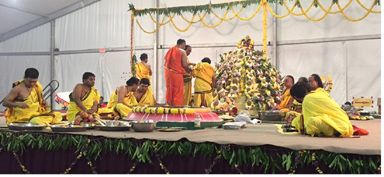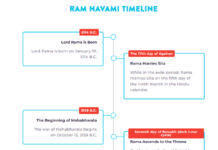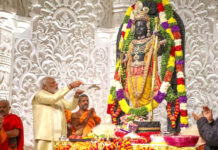
CHICAGO: The Hindu Temple of Greater Chicago hosted a historic and massive three-day convocation culminating in Maharudra Yagna for universal peace, welfare and prosperity recently.
Thousands of devotees and hundreds of priests and scholars participated in the mass chanting of ancient prayers, culminating in Maharudram Yagna, a fire sacrifice whose history dates back 5000 years.
Rudra, a deity first described in the Rig Veda, the world’s oldest scripture, appears on the surface as a storm God. But Rudra emerges in the scriptures as an embodiment of universal truth. He represents both the storms of life and our power to weather those storms and turn them into blessings.
The prayer addressed to him transforms into a deep meditation on the fundamentals of a conscious and compassionate life. Rituals include the great yagnas, which involve offering oblations of clarified butter, symbolic foods, cloth, and therapeutic herbs into a sacred fire in precise unison with the chanting of Sanskrit verses.
HTGC Priest Sri Vengatesa Sivacharyar, with the support of Sri Dharmarao Nellivalasa, led and guided a team of priests from Chicago as well as other temples to conduct every step of the three-day ceremony exactly as prescribed by scriptures. During planning discussions, he spoke of the importance of not simply chanting correctly and performing the proper actions, but of creating a sustained vibration that would resonate in the bodies and minds of everyone present and help them reach a higher spiritual state.
The Maharudram event drew attendance and support from a vast array of local, national, and international spiritual, political, and community leaders, including Satguru Bodhinatha Veylanswami, the US-born spiritual head of Himalayan Academy, Hawaii; Swami Ishatmananda of the Vivekananda Vedanta Society, Chicago; Swami Ramanaswaroopananda of Atma Vidya Mandir, Tiruvannamalai; Sri Samaveda Shanmuka Sarma, Hyderabad and Sri Swami Adhyatmanandaji Maharaj, Ahmedabad.
The President of The Hindu Temple of Greater Chicago Bhima Reddy and the Chairman of the Maharudram Committee Lakshman Agadi led the large congregation in honoring the visitors from India, Hawaii, and all over North America with fresh flower garlands and gifts, paying respect to their various religious orders.
Maharudram committee co-chairs Dr. Vijaya Sarma and Gopalakrishnan Kari, with the support of core committee members Subramanian Sundaram, Ananth Subramanian, Sriram Sankaran, Vishi Viswanath, Sridevi Kurella, Gurudutt Ramamurthy, Abhishek Gawasane, Sivaraman. Sivasubramanian planned with the help of religious scholars for over a year to ensure that the ritual, the prayer, and the geometry of the sacred space itself remain virtually unchanged from yagnas performed millennia ago in ancient India.
The master of ceremonies, Dr Sangita Rangala explained the symbolism and significance of the Mahayagna and ensured that the audience was in a positive and prayerful mood for the entire duration. Over a hundred children knotted traditional flower garlands and brought them in a procession to offer to the deity. The priests received them and used them to decorate the 121 kalasams spectacularly displayed as Mount Meru.
At the start of the day’s Maharudram Yagna ceremony, the priests led the assembled 2000-plus in Sanskrit prayers which listed the names of sacred places the congregation calls home. Along with the names of places in India and rivers like the Ganga, the priests chanted the names of the Missouri and Mississippi rivers, Michigan and Alabama.
Friday’s events celebrated the power of women and girls, central to Hindu and Vedic philosophy. Nearly 1300 women and girls chanted in unison the Lalita Sahasranama, a poem listing the 1008 names of the Supreme Goddess, who embodies the essential power and love of the universe.
Seated row upon row in a sea of colorful silk and gold saris, the women and girls sat in front of small, individual statues of the Goddess and prayed and meditated as one. Priests led the recitation of the 1008 names, offering flowers and fruit to the statue of the Goddess, a symbolic representation of the divine feminine power, or Shakti.
A literary and spiritual masterpiece composed with perfect meter and no repetition, the Lalita Sahasranama uses the 1008 names to describe 1008 universal or divine qualities which are manifested in the world and in the individual. The vibrations of the chanting and its spiritual counterpart are said to have healing and liberating power for those who chant and listen.
The Lalita Sahasranama pooja, or offering of prayer, was preceded by a Gomata pooja, or worship of a cow and calf
In keeping with tradition, dozens of volunteers prepared thousands of fresh meals in the temple’s kitchen. And in a sign that the event was truly a 21st century version of a 5000-year-old tradition, a quadricopter drone took aerial live streaming video and children got a 3D virtual walk through famous temples in India.
Sunday culminated with the Nava Chandi Homam, 14 simultaneous fire sacrifices with offerings of ghee, clarified butter, flowers, fruit, and special preparations of therapeutic herbs, seeds, and aromatic wood. Devotees chanted verses praising the feminine aspect of divinity, embodied as the Goddess.
Seated in front of the priests’ large fire pit in squares of 16 people around 13 smaller copper fire pits designed according to geometry prescribed in the Atharva Veda, worshippers praised the Goddess’s various qualities: she is omnipotent and terrible to those who would do harm, tender and all-protective to those who have faith and seek peace within and without.
Despite severe thunderstorms and flash floods, devotees could sit comfortably through the three-hour ceremony and focus their meditation on the 700 verses of the Devi Mahatmyam, one of the most treasured scriptures in praise of the Goddess.
The Goddess in her multiple incarnations represents universal forces of power and compassion. When the forces of greed, exploitation, oppression, and patriarchy grow too great, the Goddess manifests herself to destroy evil and restore harmony. In Indian philosophy, the concept of God is of a truth that lies beyond gender, form, ethnicity, time, and space. Rather, this Ultimate Truth manifests itself.
The final pooja offering celebrated this union of Shiva and Shakti, Rudra and Devi, individual soul and universal consciousness. Whether it was the sweet fragrance of the smoke, the soothing sounds of the Sanskrit verses, or the way the storm clouds gave way to the morning sun, the smiles and tears and rapt attention of the participants showed that the mood Sunday morning had turned to pure joy and togetherness.
Organizers finally were successful in their original intent behind the Maharudra Yagna to help worshippers transcend the realm of fear and doubt, and keeping up the 5,000 years traditions to discover the divinity within oneself and each other.
Vikram Rangala






